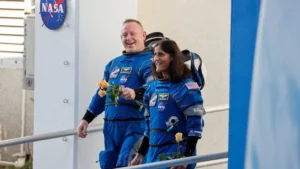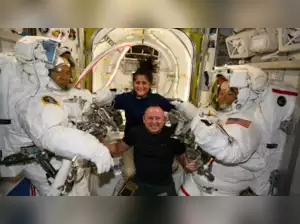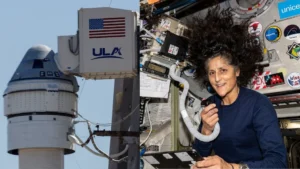A New Twist in NASA’s Space Mission
NASA’s space missions have always captured the imagination, but the latest developments surrounding the SpaceX Crew-9 mission have taken an unexpected turn. With just weeks left before the scheduled launch, NASA has announced a significant change to the mission’s crew composition. What was originally a four-member team is now downsized to two, a decision that has raised eyebrows and questions alike. The reasons behind this change are complex, involving a mixture of technical challenges, safety considerations, and the broader goals of the mission. Yet, despite the uncertainty, the mission remains a critical step in NASA’s ongoing efforts to explore the cosmos.
The Decision to Downsize: A Balancing Act
When NASA initially announced the Crew-9 mission, the plan was clear: four astronauts would journey to the International Space Station (ISS), continuing the agency’s long-standing tradition of maintaining a human presence in low Earth orbit. However, as the launch date approached, unforeseen circumstances forced NASA to rethink its strategy. The decision to return Boeing’s Crew Flight Test uncrewed, combined with the complexities of managing an international space station, led to a pivotal choice: downsizing the crew.
Nick Hague, a seasoned NASA astronaut, was appointed as the mission’s commander, a role that requires not just technical expertise but also leadership under pressure. Joining him is Roscosmos cosmonaut Aleksandr Gorbunov, who will serve as the mission specialist. This duo will now be responsible for the mission’s success, a burden that would have been shared among four but must now be managed by two.
NASA Chief Astronaut Joe Acaba explained the reasoning behind this decision, emphasizing the need for an experienced commander who can handle the intricacies of the ISS’s operations. “While we’ve changed crew before for a variety of reasons, downsizing crew for this flight was another tough decision to adjust to, given that the crew has trained as a crew of four,” Acaba noted. This adjustment, while challenging, is seen as necessary to ensure the safety and success of the mission.
Sunita Williams’ Extended Stay: A New Chapter

Perhaps the most surprising development in this reshuffle is the fate of astronaut Sunita Williams. Originally slated to return to Earth with the Crew-9 team, Williams will now extend her stay on the ISS until February 2025. This decision, though unexpected, highlights the fluid nature of space missions, where plans can change rapidly in response to new information and challenges.
Williams, a veteran of multiple spaceflights, has spent more than 322 days in space over the course of her career. Her extended stay aboard the ISS will push this total even higher, making her one of the most experienced astronauts in NASA’s history. For Williams, the extended mission is both a challenge and an opportunity — one that underscores her commitment to space exploration.
The Impact on the Remaining Crew Members

For Zena Cardman and Stephanie Wilson, the other two astronauts who were originally part of the Crew-9 mission, the decision to remain Earth-bound was undoubtedly disappointing. Both had trained extensively for the mission, preparing for the rigors of space travel and the scientific experiments they would conduct aboard the ISS. However, NASA’s reassignment doesn’t mean the end of their spacefaring ambitions. Both Cardman and Wilson remain eligible for future missions, and their experience and training will undoubtedly be put to use in the near future.
In their statements following the announcement, both astronauts expressed support for their colleagues and reiterated their commitment to NASA’s goals. This camaraderie and professionalism are hallmarks of NASA’s astronaut corps, where the success of the mission always comes first, even if it means personal sacrifices.
Preparing for Launch: The Final Countdown

With the crew now set, preparations for the Crew-9 mission are in full swing. The launch, scheduled for September 24, 2024, will mark the beginning of a critical period for NASA and its partners. As Hague and Gorbunov complete their final pre-flight checks, the broader mission objectives come into focus.
One of the primary goals of the Crew-9 mission is to ensure the continued operation of the ISS, which has now been in orbit for over two decades. The ISS serves as a hub for scientific research, allowing scientists to conduct experiments that are impossible on Earth. From studying the effects of microgravity on the human body to testing new technologies that could one day be used on Mars, the ISS is a cornerstone of humanity’s efforts to explore space.
The reduced crew size means that Hague and Gorbunov will have to shoulder a greater workload than originally planned. However, NASA is confident in their abilities, and the two astronauts have undergone extensive training to prepare for the challenges ahead. Their mission will include a mix of routine maintenance, scientific research, and, of course, ensuring that the ISS remains operational for future missions.
Also Read: https://newsreporto.com/boeings-starliner-faces-major-setback-loss/
The Broader Implications for NASA and SpaceX
The changes to the Crew-9 mission are more than just a logistical adjustment — they represent a broader trend in NASA’s approach to space exploration. As the agency continues to partner with private companies like SpaceX, the dynamics of space missions are evolving. The decision to downsize the Crew-9 mission highlights the flexibility and adaptability that NASA must maintain as it navigates these new partnerships and the challenges they bring.
For SpaceX, the Crew-9 mission is another opportunity to demonstrate the reliability and capability of its Dragon spacecraft. While the company has successfully completed several missions to the ISS, each new launch presents its own set of challenges. The success of Crew-9 will be another milestone for SpaceX as it continues to play a central role in NASA’s human spaceflight program.
Looking Ahead: The Future of Human Spaceflight
As NASA prepares for the Crew-9 mission, the agency is also looking to the future. The Artemis program, which aims to return humans to the Moon and eventually send them to Mars, is the next major frontier for space exploration. The lessons learned from missions like Crew-9 will be invaluable as NASA and its partners push the boundaries of what is possible in space.
For Sunita Williams, Nick Hague, Aleksandr Gorbunov, Zena Cardman, and Stephanie Wilson, the journey continues. Whether aboard the ISS or back on Earth, these astronauts are part of a legacy that spans generations — a legacy that will continue to inspire future explorers for years to come.
The Countdown Begins
As the countdown to September 24th continues, the eyes of the world will be on NASA and the Crew-9 mission. With a reduced crew and the unexpected extension of Sunita Williams’ stay on the ISS, this mission is a reminder of the unpredictability of space exploration. Yet, despite the challenges, the mission promises to be another step forward in humanity’s quest to explore the cosmos.

